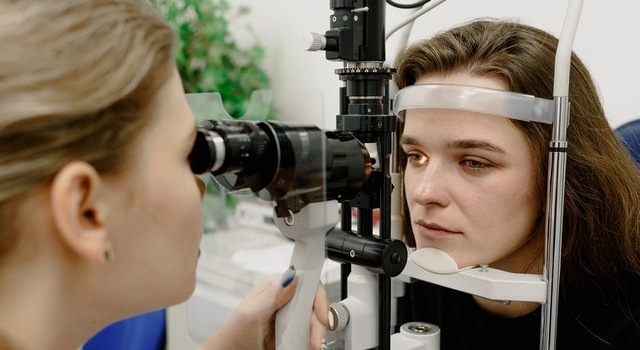
Your eyes are not only the windows to your soul, but they also hold the key to your overall health. Comprehensive eye exams go beyond just evaluating your vision and can reveal a lot about your health, including the presence of 20 different diseases.
As a family optometry practice in Madisonville, we believe that regular eye exams are essential for the health and well-being of the entire family. Don’t delay, schedule your appointment today!
Comprehensive Eye Exams
A comprehensive eye exam includes a series of tests to evaluate your vision, eye muscle movement, and the overall health of your eyes. These tests include visual acuity, color vision, depth perception, and visual field testing. It’s critical to provide a comprehensive family and medical history to your optometrist during your eye exam, to help identify potential risks.
Importance of Regular Eye Exams
Regular eye exams help detect vision problems early on, which can prevent major issues and provide a better chance for successful treatment. It is recommended that adults get a comprehensive eye exam every one to two years. Children should have their first exam at six months, then at three years old, and again before starting school. After that, children should have an eye exam every year, depending on their vision requirements.
Early Detection Can Prevent Major Issues
Many health issues, including those not directly related to the eyes, can be detected during a comprehensive eye exam.
1. Aneurysm
An aneurysm is the bulging or ballooning of a blood vessel, and symptoms may include a severe headache or loss of facial or body function. A comprehensive eye exam can detect an aneurysm in the eye by looking for signs in the retina. Aneurysms can be life-threatening and need urgent medical intervention.
2. Brain Tumor
A comprehensive eye exam can detect signs of a brain tumor by examining the optic nerve, which connects the eye to the brain. A tumor in the brain puts pressure on the optic nerve and can cause blurred vision, double vision, or even vision loss. Other signs include abnormal eye movements and changes in pupil size or shape.
3. Diabetes
Early signs of diabetes can be detected through an eye exam. Diabetic retinopathy occurs when high blood sugar levels damage the blood vessels in the retina, leading to vision loss. Individuals with diabetes should undergo regular eye exams to detect and monitor any potential diabetic eye complications. The longer you have diabetes, the more likely you are to experience vision problems.
4. Giant Cell Arteritis
Giant cell arteritis (GCA) is a condition in which the arteries in the head and neck become inflamed, leading to symptoms such as headache, fever, and vision problems. An eye doctor can detect GCA by looking for swelling and inflammation of the blood vessels in the retina. This condition can lead to a range of serious complications, including blindness, stroke, and aortic aneurysm.
5. Heart Disease
Heart disease can impact the blood vessels in the eye. Optical coherence tomography is an imaging tool used to carefully examine the retina. By analyzing the retina in this way, eye doctors are able to detect tiny indicators of an eye stroke.
6. High Cholesterol
In individuals aged 40 and under, a yellow or blue ring around the cornea or deposits in the retina's blood vessels may indicate high cholesterol. If left untreated, it can increase the risk of a life-threatening stroke.
7. High Blood Pressure
Hypertension, often referred to as high blood pressure, is a widespread condition that affects many people. It can cause unusual bends, kinks, or bleeding in the blood vessels located in the back of the eye. If left untreated, high blood pressure can increase a patient’s risk of developing glaucoma, diabetic retinopathy, macular degeneration, and other eye diseases.
8. Lupus
Lupus is an inflammatory disease that can lead to various symptoms throughout the body. One common symptom is dry eyes, which can be detected during a comprehensive eye exam. Additionally, lupus can cause swelling in various parts of the eye, including the white part (sclera), middle layer, and light-sensitive tissue in the back of the eye.
9. Lyme Disease
Lyme disease is an infection spread by ticks, which causes inflammation throughout the body, and in some cases, inflammation of the optic nerve. It can also lead to an increase in floaters, small — dark spots or specks that appear in a patient’s field of vision.
10. Medication Toxicities
Certain medications can irritate the eyes. Symptoms may include red and scaly eyelids, red eyes, scratchy corneas, or conjunctivitis, which can all be detected during a comprehensive eye exam.
11. Multiple Sclerosis
The brain and spinal cord are both affected by a neurological disorder known as multiple sclerosis. A comprehensive eye exam can detect signs of multiple sclerosis, like painful eye movements, and blurred or double vision.
12. Myasthenia Gravis
This is an autoimmune disorder that can cause weakness and fatigue in muscles. Initial symptoms often appear in the eyes, such as drooping eyelids, double vision, and other issues that can easily be detected during a comprehensive eye exam.
13. Rheumatoid arthritis
An immune disorder known as rheumatoid arthritis (RA) causes chronic inflammation. It can also affect the eyes, resulting in dry eyes, redness, pain, and even vision problems. In some cases, RA can cause scleritis or uveitis, which are both serious eye conditions.
14. Sarcoidosis
This is an inflammatory disease that can affect many organs, including the eyes. Eye symptoms of sarcoidosis can include redness, pain, light sensitivity, and blurred vision. Additionally, sarcoidosis can cause iritis, which is an inflammation of the iris.
15. Sexually Transmitted Diseases
Certain sexually transmitted diseases (STDs), such as chlamydia and gonorrhea, can cause eye infections. Regular eye exams can help detect and effectively treat any potential issues.
16. Sickle Cell Disease
Red blood cells' structure is impacted by sickle cell disease, a genetic blood disorder. Several ocular changes can result from this disease. It can range from mild redness and burst blood vessels on the surface of the eye, to severe hemorrhages and retinal detachment inside the eye. People with sickle cell disease should undergo regular eye exams to protect their vision.
17. Sjögren's Syndrome
Sjögren's syndrome is an autoimmune disease that can cause severe dry eyes. It may lead to eye irritation, inflammation, and corneal damage, which can result in vision loss, if left untreated.
18. Stroke
A stroke can affect the eyes in several ways, including sudden vision loss, double vision, or blurred vision. A blockage or bleed in the blood vessels that supply the eyes or the brain can cause these symptoms.
19. Thyroid Disease
When the thyroid gland produces too little or too much thyroid hormone, thyroid disease occurs. A comprehensive eye exam can detect the early signs of thyroid disease, such as bulging eyes or changes in eye movements.
20. Vitamin A Deficiency
Vitamin A deficiency can cause a range of eye problems, including night blindness, dry eyes, and a condition called Bitot's spots, which appear as white, foamy patches on the eyes. Vitamin A insufficiency can, in severe situations, cause blindness.
Regular eye exams are vital for the early detection of various systemic diseases. The eyes truly are windows into the body, and a comprehensive eye exam can provide important insights into a person's health status.
Eye Exams in Madisonville, KY
Don't neglect your eye health! Schedule an appointment with the experienced team at Family Eye Site to get a comprehensive eye exam and ensure that your eyes — and health — are in tip-top shape.
